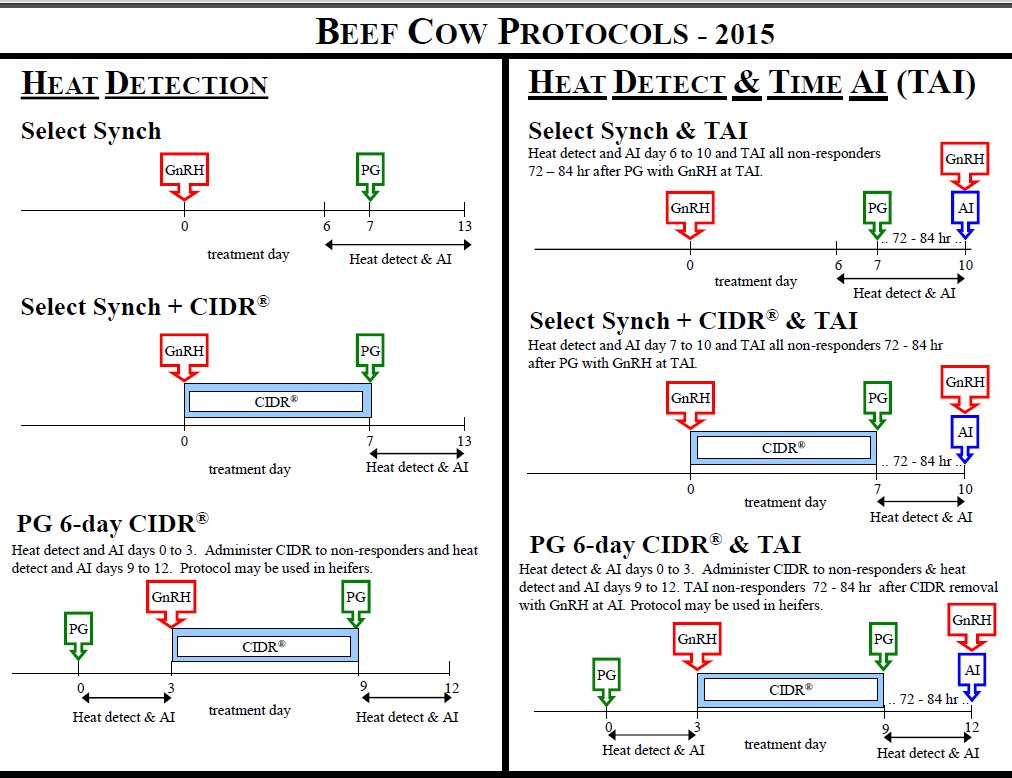
By Bethany Johnston, Nebraska Extension Educator and Rick Funston, UNL Beef Reproductive Physiology Specialist
Synchronizing estrus in your beef herd can shorten your calving season, produce more uniform calf weights, and last but not least, provide the opportunity to use proven genetics through artificial insemination (AI). As cowherds rebuild, many producers are synchronizing heifers and replacing bull power with AI sires as bull prices increase.
Consider the following if you are thinking about employing an estrus synchronization system:
*WHICH PROTOCOL WILL YOU USE? Synchronization programs are numerous, and vary from one injection to more intensive systems. Suggested protocols are updated annually and available at http://beefrepro.unl.edu, on the RESOURCES page. Find a protocol that best matches your manpower, facilities, timeline, and budget. The AI Cowculator, a smartphone app, can help determine the economic viability of implementing a synchronization and AI program. The AI Cowculator is also available at http://nfrec.ifas.ufl.edu/programs/AICowculator.shtml
Some protocols, such as feeding MGA to heifers, require planning ahead. Treatment with MGA must start about 40 days before you plan to breed. Don’t forget to allow extra time to order and ship needed supplies. Other protocols require less planning ahead, so look at options that work for you.
*WHO’S DOING THE BREEDING? You have made the commitment to synchronize your cattle, so they will come into estrus in a short amount of time. Will you AI the cattle or use natural service?
If you don’t have the skills to AI cattle, consider letting a professional technician AI for you. In a fixed time AI setting, which eliminates the need for heat detection, arm fatigue is a real concern and a professional may be the best option. Their services range from AI only, to the entire estrus synchronization and AI process. Technicians may also have a portable AI barn, which can make cattle handling easier during AI.
Synchronization protocols should be followed as written or pregnancy rates can suffer, cancelling the benefits synchronization can provide. Giving injections at the wrong time or the wrong amount, not identifying heifers in heat, storing frozen semen improperly, post-thaw temperature damage or in too much light, and depositing semen in the wrong location can lower pregnancy rates. Regardless of whether a synchronization protocol is used, pregnancy rates are also affected by herd fertility, nutritional status, body condition, and postpartum interval.
*WHAT BULL TO COW RATIO DO I NEED? Obviously, letting the bulls do the breeding during a synchronized estrus will cut down on labor needs. In experiments when natural service is used with estrus synchronization, Dr. Rick Funston (Nebraska Extension Beef Reproductive Physiologist), suggests using the same recommended ratio of bulls to cows you would without synchronization (in the 1 bull to 20 cows range), making sure all bulls are breeding females and none become injured during the peak estrus period. More intensive management may also be warranted during this period such as having them in smaller pastures and checking them more often so problems are found early.
What if you AI and then use bulls to breed those not conceiving through AI? You will need about half of the bulls you normally use. Cows not becoming pregnant after a synchronized estrus do not all come back in to heat on the same day. Their return to estrus is distributed over a period of days, allowing bulls to breed the same number as normally anticipated.
When determining the number of clean-up bulls needed, Dr. Funston proposes assuming a 50% AI conception, allowing the bulls to breed the remaining 50%. “In our experience, we use approximately half the recommended bull to cow ratio after synchronization and AI and we’ve gotten along well.”
Dr. Funston notes most AI programs will have a better than 50% conception rate, but uses the conservative number to ensure enough bulls. In several published studies using a bull to cow ratio of 1:20 to 25 resulted in a similar final pregnancy rate, when compared with a bull to cow ratio of 1:50 to 64 (91 to 93% final pregnancy rate) after synchronization and AI.
Recommendations are approximately 20 to 25 non-pregnant females per bull, but yearling bulls may breed a few less. Check bulls often for lameness or stiffness, and remove and replace injured bulls. Many factors influence the “optimum” bull to female ratio in a given scenario, such as pasture size, number of watering areas, and bull age.
If you are using bulls, be sure to have your veterinarian conduct a bull breeding soundness exam 1 to 2 months prior to breeding. This gives you time to treat bulls or find replacements.
The bull breeding soundness exam is more than semen evaluation. Physically examining the bull is also important. Evaluate the soundness of the feet and legs, scrotal size and shape, and examine the underline.
CALVING DISTRIBUTION, WHAT TO EXPECT: Research has demonstrated heifers and cows that conceive on the same day will have calves born over a 16 to 20 day period, with the majority born in a 10 day period. Most reports indicate the peak calving day had 10 to 15% of calves born. Make sure your labor and facilities will accommodate these numbers in case of inclement weather, like blizzard conditions. Most information suggests a 283 day gestation length in heifers; however, when using extreme calving ease bulls expect to start calving prior to 283 days. In one data set with heifers mated to a calving ease sire, calving began 14 days early with 73% born prior to 283 days of gestation http://www.noble.org/Ag/Livestock/AICalvingDistribution/.
Start thinking about your operation and if synchronizing could benefit your cowherd. Breeding season is just around the corner!
Dr. Funston’s contact information is:
Rick Funston
University of Nebraska
West Central Research and Extension Center
402 West State Farm Road
North Platte, NE 69101
308-696-6703
rick.funston@unl.edu